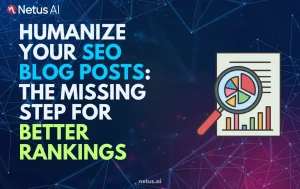
Why Google’s ‘Who, How, Why’ Framework Matters for EEAT | NetusAI
Why Google’s ‘Who, How, Why’ Framework Matters for EEAT AI can create articles in seconds. But here’s the truth: speed is not enough. Google wants

Content writer and editor for Netus.AI
Anti-Plagiarism Software Features, Uses, and Benefits. Plagiarism is a critical concern in both educational and professional realms across the globe. When individuals present someone else’s work or ideas as their own without proper attribution, it’s not only deemed unethical but can lead to serious consequences. With the proliferation of digital content, it’s even more significant to protect intellectual property and maintain academic integrity.
Utilizing anti-plagiarism software has become an essential solution to combat plagiarism effectively. These tools employ advanced algorithms, database software, and artificial intelligence to scan and compare texts with existing resources, ensuring that submitted works are original and well-cited. As a result, students, educators, and professionals alike can avoid the pitfalls of plagiarism and uphold the value of original content.
Plagiarism can take on various forms, with some being more apparent than others. It is essential to understand these distinctions to prevent committing such acts, whether intentional or accidental. The following are the main types of plagiarism encountered:
Being aware of these distinct forms of plagiarism can help writers maintain academic integrity and foster originality in their work. To provide proper credit to original authors and avoid any accidental plagiarism, using citation generators can also prove to be beneficial.
How to remove plagiarism from ChatGPT? Plagiarism checkers are valuable tools for writers, teachers, and students alike, as they help to identify copied content and maintain the integrity of academic and professional works. With the continuous advancements in technology, plagiarism checkers have become more effective and user-friendly. Incorporating features like artificial intelligence, cheat detection, and efficient reporting, these tools are invaluable in detecting similarities and ensuring the originality of written content.
One significant advantage of using a plagiarism checker is the integration of Artificial Intelligence (AI). AI-powered plagiarism scanners can distinguish between word-for-word plagiarism, partial plagiarism, and paraphrased content, providing clear and actionable reports for the user. This increased accuracy and understanding of context can enhance the user experience and make it easier to address flagged content.
Cheat Detection is another essential feature in plagiarism checkers, particularly for educators evaluating student papers. As cheating techniques continue to evolve, plagiarism checkers need to keep up with these changes to stay effective. By incorporating AI, these tools can now identify and flag content that uses various cheating methods, such as white characters, foreign symbols, and removed words within sentences.
Plagiarism checkers have evolved to scan URLs in addition to text input, making it easier for users to check content directly from a web page. This feature ensures that even if there are redirects or URL parameters in place, the checker can accurately evaluate content for potential plagiarism.
Creating clear and concise reports is crucial in a plagiarism checker, as the user needs to have a thorough understanding of their content’s originality. Modern plagiarism tools can segregate each type of plagiarism with different colors, provide detailed information on the original sources, and highlight exact areas of copied content. This saves time by allowing users to quickly address the areas in need of revision without having to guess where the issue lies.
The Text Compare feature offers additional convenience by allowing users to compare multiple articles or URLs for duplicate content. This helps users identify instances of self-plagiarism, which can occur when similar ideas from previously published works appear in a new piece.
Checking for self-plagiarism is another essential aspect of plagiarism detection. Premium plagiarism checkers can store previously scanned documents in their databases, ensuring they are evaluated alongside other web resources when checking new content. This feature not only helps in identifying self-plagiarism but also spots instances of plagiarism from internal links.
In conclusion, plagiarism checkers are essential tools for maintaining the integrity of written works and ensuring originality in the age of digital plagiarism. From providing helpful reports to detecting cheating techniques, these tools are an invaluable resource for writers, teachers, and students alike.
Yes, many anti-plagiarism tools can be integrated with Learning Management Systems (LMS) and other educational platforms. This integration allows educators to seamlessly check assignments for plagiarism directly within the LMS, streamlining the grading process and improving efficiency.

Why Google’s ‘Who, How, Why’ Framework Matters for EEAT AI can create articles in seconds. But here’s the truth: speed is not enough. Google wants

SEO Writer’s Guide to Google’s Helpful Content Update Keeping up with Google’s algorithm changes can feel like a relentless game of whack-a-mole. Just when you

Can AI Content Be Safe for SEO in 2025? Let’s start with the question of keeping every content strategist, SEO pro and blogger awake at

Humanize Your SEO Blog Posts: The Missing Step for Better Rankings You’ve done everything by the book. Your keyword research is impeccable. Your meta descriptions

How to Pass AI Detection Tests as an SEO Writer Let’s paint a familiar picture. You’ve just finished a blog post. The headline is sharp,

Why Your AI SEO Blog Isn’t Ranking (And How to Fix It) You embraced AI for your blog. The promise was intoxicating: high-quality content, published
@ 2024 Netus AI.